Sibiu is one of the most popular travel destinations in Romania. The historic city in Transylvania has a long and interesting history that is visible across the city. A mix of historic, picturesque and peculiar attractions have made Sibiu one of the most popular travel destinations in Romania.

The historic region of Transylvania was once an ethnically diverse region. A blend of Saxons, Swabians, Hungarians and more, Lutheranism and Catholicism were the dominant Christian denominations. Prior to World War I, Sibiu was home to more Germans and Hungarians than Romanians.
The history of Sibiu (and Transylvania, in general) is what makes it such a great place to travel. Residents of the past left their mark on the city, and the historic old town is extremely well-preserved. This led to Sibiu being named a European Capital of Culture in 2007.
Today, the area is overwhelmingly Romanian. Ethnic Germans and Hungarians emigrated or were pushed out over the course of the 20th century. Only a few thousand remain in Sibiu today. From architecture to food, the impact of their ancestors remains visible and a reason Sibiu is a popular place to visit today.
Here’s what you need to know about travel to Sibiu, Romania:
Contents
Highlights & Top Attractions of Sibiu
The historic city of Sibiu, the old town, is roughly divided into two portions: the Upper Town and the Lower Town.
The Upper Town is where most of the top attractions in Sibiu are located. This is also where a majority of tourists spend their time. The primary exception to this is the portions of Lower Town that are right next to Upper Town. Here, there are a few cafes, shops and sites. For the most part, though, Lower Town is quiet.
For obvious reasons, Upper Town is the part of Sibiu that receives most of the attention. That doesn’t mean you should ignore the lower portion of the historic old city.
I thoroughly enjoyed walking around the Lower Town. It is predominantly residential, though you will see the occasional shop or BnB.
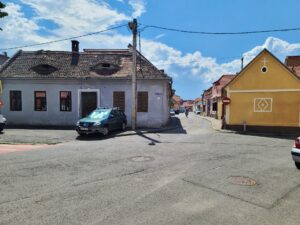
The calm walks through the Lower Town are a great opportunity to see a historic side of Sibiu without the crowds. As you venture further out, there are other interesting places to visit. One of my favorite spots in Lower Town is not of the calm variety. Rather, the Piata Cibin (Cibin Market) is a local market. You can find almost anything you can imagine here.
The market certainly reminds one that Romania was a Communist state for decades, but it also is a brief glimpse into local life. If you’re staying in Sibiu for an extended period of time, you’ll want to shop here to save money and buy local.
Medieval Towers & City Walls
A walk through Sibiu’s historic center is surreal. There is a strong postcard feeling around every corner. As a city dating back nearly a thousand years, Sibiu’s history includes much from the Medieval period. With effective preservation efforts, many of the city’s medieval structures are still visible. In particular, the towers and walls are notable marks of the city.

There aren’t many places in the world where you can climb 12th Century towers or enjoy your morning coffee atop an 800-year-old wall.
The City Walls of Sibiu are largely part of existing buildings or parks that are there for your viewing pleasure. A couple of sections of the walls are part of museums and not always open to visitors. For the most part, though, they are there for your enjoyment.
The medieval towers of Sibiu stand out more. This might be because they tower above adjacent structures.

What I love about the towers of Sibiu is that several are still open to visitors. They aren’t really that tall, but most buildings in Sibiu’s historic center are only a few stories high. While other structures are taller (see next section), the views from the towers are unique.
Some of the towers are part of historic city defenses. Others were built by certain guilds. For instance, there is a Tinsmith’s Tower, a Tanner’s Tower and Potter’s tower.
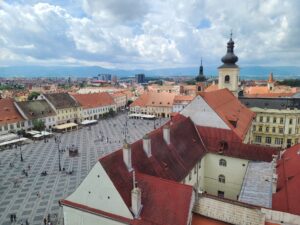
Turnul Sfatului, the Council Tower of Sibiu, is one of the most iconic landmarks in the city. It is hard to miss, separating the Grand and Small Square. Although other points are higher than this tower, the view from the Council Tower is hard to beat. It has great views of both squares, the immediate surrounding area and the large Cathedral nearby (see below).
The Council Tower of Sibiu is another great thing to do owing to the ease of climbing. As stated, it’s not that tall, but the views atop are much better than one might expect. It’s also a super cheap thing to do. Admission costs a mere 2 Lei – that’s about fifty cents! Climbing an 800-year-old tower to find a great view for less than a dollar – what a great reason to love Romania.
Churches of Sibiu
Sibiu’s rich religious history makes it a great place to visit a few spectacular churches. Of these, there are a few especially remarkable churches that you need to visit.
There are Catholic, Protestant and Orthodox Churches worth visiting in Sibiu. These make for excellent studies of architecture, regional history, religion, art and more. Sibiu’s churches help to create the picturesque scene that is this historic city. And there are even some fantastic views.
These two stand out from a city full of exceptional churches:
Lutheran Cathedral of Saint Mary
The Lutheran Cathedral of Saint Mary is one of the most obvious landmarks in Sibiu. The church is visible from across the city.
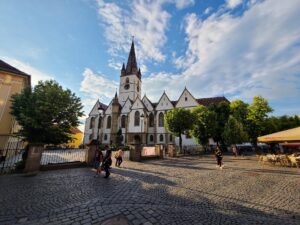
This large Lutheran Cathedral was completed over 500 years ago. It is famous for its organs, so don’t miss the chance if you have the opportunity to hear them roar.
Despite being one of the largest and most visible structures in Sibiu, the Lutheran Cathedral functions more as a museum today. The local Lutheran community, consisting primarily of ethnic Germans, is a fraction of its historical size.
A tour through the Cathedral is interesting in the sense that it provides a stark contrast to the ornate interiors of Catholic churches and the relic-filled interiors of Orthodox churches. It is clearly a Protestant building.
The highlights of the exterior are the colorful designs of the shingles on the roof and the large tower. The tower of the church rises nearly 250 feet high.
A climb up the tower of the Lutheran Cathedral of Saint Mary is one of the best things to do in Sibiu. This is where you’ll find the best view in town. The walk to the top involves plenty of stairs. It’s not an extreme physical undertaking, but you’ll probably break a sweat.
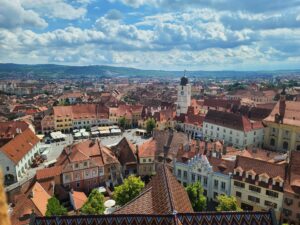
Although the Cathedral interior is notably Protestant and lacking over-the-top decor, it is still very nice. However, I would suggest skipping a visit to the church portion and sticking with the tower.
Why? It’s not free. It’s barely more than a dollar, but that’s not the point.
It irks me, to say the least, when active churches charge admission for entrance. Yes, this church functions more as a museum today, but it is not officially designated as such. Without going further into that, I can understand paying to visit the tower only. This requires upkeep for safety purposes, and heavy foot traffic impacts structural integrity. In the case of Sibiu’s Lutheran Cathedral, stick to paying to climb the tower. The view is unquestionably worth the 10 Lei price of admission.
Romanian Orthodox Holy Trinity Cathedral
The Holy Trinity Cathedral is the largest Romanian Orthodox church in Sibiu. The Byzantine style stands out among the predominantly Hungarian and German architecture you see in Transylvania.
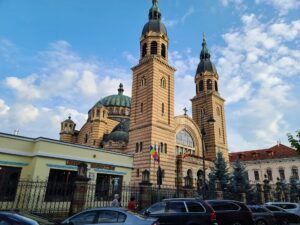
The Orthodox Holy Trinity Cathedral is not as old as most of the other churches of Sibiu. It dates to the early 20th Century.
Don’t let its relative youth deter you. Orthodox churches are interesting sites to see for those more familiar with Western sites, and this Cathedral is magnificent. With inspiration from the Hagia Sophia, the Byzantine style dominates the structure, but there are elements of Transylvania, too.
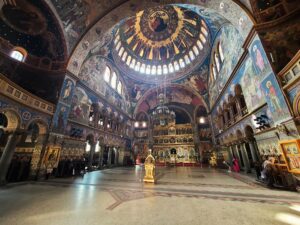
The interior is unquestionably Orthodox. It is fairly dark, with lots of shiny relics and wall-to-wall artwork, beneath an enormous dome. There is no entrance fee.
Sibiu’s Historic Squares
The historic city of Sibiu has two primary squares – Piata Mica and Piata Mare. These translate to Lesser Square and Grand Square (or Small/Little Square and Big Square), respectively.
Naturally, Sibiu’s famous squares are the centers of tourism in the city. They are remarkably well-preserved, with most of the buildings dating back hundreds of years.
The best part about the Grand Square and the Small Square in Sibiu is that you can enjoy these spaces the way you want to and do so affordably. Most photogenic and historic squares of Europe are lined with restaurants, the ideal spot to grab a drink or bite to eat, take in the scene before you and watch for hours.
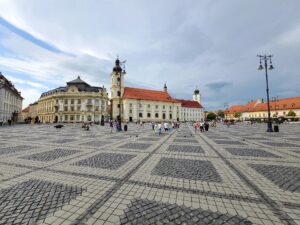
Most of these picturesque, cafe-lined squares of Europe are also expensive places to sit and watch the world move along.

Romania is different. It’s cheap. You can affordably sit for a couple of hours in Sibiu’s Grand Square and have a few beers or glasses of wine. I did this on a few occasions. Romanian brews set me back less than $3 per beer. Local wine is only slightly more expensive.
One afternoon, I ate lunch in the Small Square. An entire pizza plus two beers was about $8, fantastic view and tip included.
If you’re on a mission to eat and drink as cheap as you possibly can, skip the cafes in the squares. This is the center of the historic old city, the center of tourism in Sibiu. So, yes, it is generally the most expensive area to eat and drink. But ‘expensive’ in Romania isn’t the same as expensive – or even average – in much of Western Europe.
But where else can you have a $2 beer in a historic square in Europe? There aren’t many options. Even the more expensive places in Romania are cheaper than comparable sites across Europe.
Take advantage of the chance to enjoy a moment to slow down in an historic location surrounded by centuries-old beautiful buildings. There aren’t many places in Europe where a budget traveler can do this, and who knows how long that will be the case in Romania.
Bridge of Lies
The Bridge of Lies is a small, unassuming footbridge in the center of Sibiu. It spans a pedestrian street that connects the Small Square with lower portions of the historic city center.
Aside from being architecturally significant – it is the second-oldest cast iron bridge in Europe, so that’s something – the Bridge of Lies isn’t that important. As far as bridges go, it’s a nice one. And the location does make for a nice photo.
The top of the bridge is where you’ll find most of the photo-takers. It’s definitely one of the top ‘selfie spots’ in Sibiu.
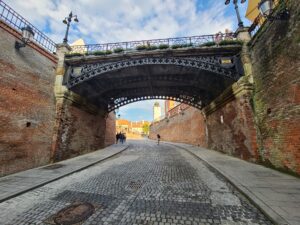
The interesting thing about Romania’s oldest cast iron bridge are the fun legends with which it is associated. The local legend here is that the bridge will collapse if you tell a lie while standing upon it.
Hopefully, the structural integrity of the Bridge of Lies is not dependent upon your honesty. Even so, test the legend at your own risk!
Sibiu’s Bridge of Lies is a nice landmark, though. And the location directly adjacent to the Small Square makes this an easy thing to do in Sibiu. Make sure to snap a few pictures, and tell the truth when you’re standing there!
The Eyes of Sibiu
The most intriguing travel attraction in Sibiu is the famous “Eyes of Sibiu.”
All across the city, roofs of buildings and homes are adorned with dormers that look like watching eyes. The dormers are a little creepy but also humorous.
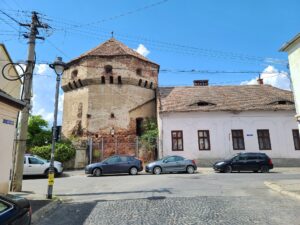
Despite legends claiming the dormers are meant to appear like they are spying on you, the ever-watchful Eyes of Sibiu are little more than a local trend from some 500 hundred years ago. They do, however, make for a fun and curious feature of the city.
Dormers of this type can be seen in other places in Transylvania, but Sibiu has the highest concentration. At times, you genuinely feel like someone is watching you as you turn a corner and suddenly meet two giant eyes straight ahead. I had a bit of fun with them, as you can see below.
View this post on Instagram
Stroll Around “New” Sibiu
Most visitors do not leave the historic center of Sibiu. To be fair, there’s plenty to do here to occupy your time. However, the city in the 21st Century is much more than a quaint, old town.
There are not a lot of historic sites or pretty buildings in the newer portions of Sibiu. It is an interesting contrast to the old town, though. The marks of Communist architecture are abundant. If you enjoy seeing a place beyond the postcard views and ‘insta-worthy’ scenes, take a walk away from Sibiu’s historic center.
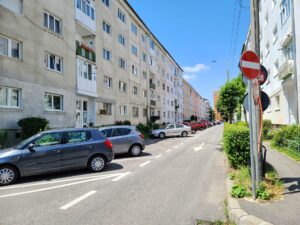
This is where most locals live and spend their time. If you want some semblance of authenticity when you travel to Romania, make sure to get away from the tourist bubbles. In Sibiu, you can walk 5 minutes from the historic center and be in a totally different place. On the positive end, New Sibiu is extremely cheap, and the people are just as friendly.
How Long Should You Stay?
I could easily spend a few weeks in Sibiu. If you use Sibiu as a base to visit nearby towns and villages, even those which might be a couple of hours away, this is a great place for slow travel. Within 1-2 hours from Sibiu, there are national parks, attractive villages, historic sites and more.
For a typical visitor, you can see the main sights and a little more in two days. The historic center of the city is where pretty much all of the notable sights are located. You can visit the churches, towers, squares and wander in between in a little more than one day. Two days allows for you to do all of this and more at a slower pace.
I spent five days in Sibiu. On one hand, I saw ‘everything’ with time to spare. At the same time, I enjoyed walking around the city and could have done so for a few more days. The extra days allow time to explore away from the historic center, an interesting contrast to the old town with few tourists and visit sites outside of town.
The overall vibe in Sibiu is calm. It’s no surprise that there is an expat community here. Whether you spend a couple of days or a couple of months in Sibiu, there is plenty to do.
Where to Stay in Sibiu
You want to stay in the city center when visiting Sibiu. Most of the attractions will be within walking distance, and there are restaurants in every direction. Romania is cheap, so you won’t have to pay typical European “city center prices.”
Accommodation in the Sibiu city center is largely small, independent operators. With a few exceptions, most of it is of the BnB or family-owned hotel variety. Staff/owners are friendly, and prices are usually affordable. Bigger hotels are not far away but will require a walk to reach the historic sites.
Maybe it’s a good thing that Sibiu’s cityscape has yet to be corrupted by large chains. The economic benefits tend to lean toward the local area. However, many travelers seek consistency and reliability when choosing where to stay during their travels. In that sense, Sibiu is lacking.
Backpackers and budget travelers don’t have many hostel options either. I love hostels for so many reasons, but most of Romania is lagging behind in the hostel game.
The two hostel options in Sibiu are B13 Hostel and PanGeea Hostel. Neither of these is great.
I stayed at B13 Hostel. The facility itself is maze-like and large. It’s a cool space and has so much potential. Staff was horrible, though. They were largely absent, offered absolutely no help in or out of the hostel and were not local. It was never cleaned, and the atmosphere was nonexistent. It pains me, because this place has so much potential to be a great hostel.
I recommend PanGeea Hostel. While I did not stay there, the reviews are slightly better. I did visit, though, and this hostel also has the coolest bar in Sibiu on site. The rooms appear to be about the same level of mediocre.
For budget travelers, hostels are still the cheapest option in Sibiu. Leave your high expectations at home. Otherwise, lodging in Sibiu is affordable, and there are plenty of small hotels from which to choose.
How to Get There
Depending on your idea of a good time, transportation in Romania for tourists can be a fun undertaking. If you don’t mind circuitous routes and long travel days through the countryside, Romania is the place for you. Be sure to check out our Romania Transportation Guide before you visit.
Sibiu’s main train station and bus station are adjacent to one another. This is where you are most likely to arrive/depart. From there, it is about a 15-minute walk to the Grand Square.

Getting to and from Sibiu is not especially difficult. It can, however, take quite a bit of time.
Despite being one of the largest cities in Transylvania and one of most popular tourist destinations in Romania, direct routes to Sibiu from other cities are few.
The easiest way to reach Sibiu from most places is via bus. If you are coming from Brasov, the train is best. Otherwise, even larger cities like Cluj and Timisoara require connections as part of long journeys.
Sibiu is less than 150 miles from Bucharest. That 150 miles takes over 8 hours by train and almost 6 hours by bus. These times assume there are no delays. We suggest taking the bus.
Taking the Bus from Bucharest to Sibiu
My bus ride from Bucharest to Sibiu was supposed to take less than 5 hours. The journey ultimately took over 6 hours. You can drive yourself in about 4 hours, but you aren’t immune to road delays.
The bus is the best way to reach Sibiu from Bucharest. It is slightly more expensive than the train, but the bus is faster and much more comfortable.

You can find the bus to Sibiu leaving Bucharest at Autogara Militari (bus station). Tickets are purchased from the bus driver. There’s no need to go inside. The bus times and destinations are listed on signs next to each berth. If you are uncertain, walk up to people near a bus and ask, “Sibiu?”
The Romanian people are generally helpful and friendly. Once you find your bus, put your bag underneath. Hop in line, and pay the driver. Seats are not reserved. Pick your favorite row, and get comfortable. It’s going to be a long but scenic ride!
I paid 84 lei for my bus. Current prices on the best site for Romanian bus transportation is 91 lei. That’s less than $20. The train is cheaper, but the bus is a far more comfortable and scenic trip.
After you arrive at the Sibiu bus station, it’s easy to reach the historic old city. You can see the church towers in the distance, slightly uphill from the station. The walk takes about 15 minutes to reach the center.
The Best Time to Travel to Sibiu
Summer is the best time of year to travel to Sibiu. Romania is fairly warm and humid during Summer months, but that is relative.
As someone who is from a place that is miserably hot from June through August (and just regular hot two months either side of that), I found the weather in Sibiu to be excellent. Days are warm, and nights are pleasant, even cool.

Rain falls evenly throughout the year, so there’s no need to avoid any kind of rainy season. I suggest packing a rain jacket.
Sibiu gets cold during Winter, but it doesn’t receive an annoying amount of snowfall. There is a ski resort less than an hour away.
Sibiu has a famous Christmas market that makes December a time to brave the cold. Naturally, it attracts a lot of visitors. For Christmas market enthusiasts, it might be a great alternative to the jam-packed, more famous Christmas markets in Western Europe.
Weather aside, the time to visit Sibiu is now. I say this because it is growing in popularity. Tourism in Romania (pre-2020) was growing due to its affordability and wide offerings of history, nature and unique culture. Sibiu is a place that combines all of that, and it will only grow more popular and busier in the years to come.
Eating in Sibiu
Eating in Sibiu is tricky. A majority of tourists will find themselves in the historic center for most, if not all, of their time here. Consequently, there are a ton of restaurants in the center from which to choose.
Restaurants are not exclusive to the squares, either. Side streets are home to more restaurants, cafes and pubs.
How do you navigate the sea of restaurants in Sibiu?
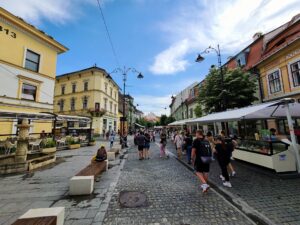
In a sense, you cannot avoid tourist restaurants in the historic center. This area is dominated by tourism, so prices will be higher than elsewhere in the city.
The good news is that Sibiu is a budget-friendly travel destination. Despite being a tourist town, it’s cheaper than Bucharest. There are ‘local’ places to eat – and you can get more details in the Hangry Backpacker’s Sibiu Food Guide soon! – but it takes a little effort.
What I like about eating in Sibiu is the ease of eating Romanian food in comparison to other popular destinations within the country. Most of the cafes in the squares serve local food. The elements of Hungarian and German influence of food in Transylvania is present in Sibiu but less so than other cities.

In general, the food in Sibiu is good and affordable. And it’s easy to find decent Romanian grub. If you want to save money, search farther away from the squares.
Sibiu is on most short lists of places to travel in Romania. Due to the culture, architecture and setting, it is also gaining notoriety as a great place to travel in general.
Romania is gaining traction as a great place to retire, largely due to the temperate climate and low cost of living. Sibiu has become the home to a growing expat community, and it’s easy to see why.
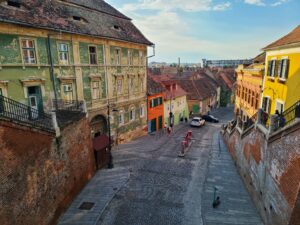
For those of us who want to visit Sibiu less permanently, the general atmosphere is an attractive one. It is an excellent place to slow down, wander around and enjoy your travel destination. From food to history, you can experience Transylvania in the ideal setting.
Romania’s capital city has a lot offer, but tourism in Bucharest often revolves around a party. That’s not the case in Transylvania. There’s fun to have, but partying is not the goal. Sibiu is a place to travel to experience Romania and appreciate its unique history and beauty.
Leave a Reply
You must be logged in to post a comment.